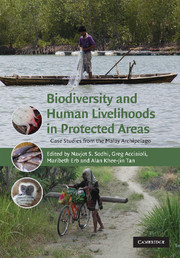Book contents
- Frontmatter
- Contents
- List of contributors
- Acknowledgements
- 1 General introduction
- Part I Conservation needs and priorities
- Part II Conservation with and against people(s)
- Part III Legal and governance frameworks for conservation
- 23 Introduction to Part III
- 24 Protected-area management in Indonesia and Malaysia: the challenge of divided competences between centre and periphery
- 25 Protecting sovereignty versus protecting parks: Malaysia's federal system and incentives against the creation of a truly national park system
- 26 What protects the protected areas? Decentralization in Indonesia, the challenges facing its terrestrial and marine national parks and the rise of regional protected areas
- 27 Learning from King Canute: policy approaches to biodiversity conservation, lessons from the Leuser Ecosystem
- 28 Conclusion to Part III
- 29 General conclusion
- Index
- References
26 - What protects the protected areas? Decentralization in Indonesia, the challenges facing its terrestrial and marine national parks and the rise of regional protected areas
from Part III - Legal and governance frameworks for conservation
Published online by Cambridge University Press: 12 November 2009
- Frontmatter
- Contents
- List of contributors
- Acknowledgements
- 1 General introduction
- Part I Conservation needs and priorities
- Part II Conservation with and against people(s)
- Part III Legal and governance frameworks for conservation
- 23 Introduction to Part III
- 24 Protected-area management in Indonesia and Malaysia: the challenge of divided competences between centre and periphery
- 25 Protecting sovereignty versus protecting parks: Malaysia's federal system and incentives against the creation of a truly national park system
- 26 What protects the protected areas? Decentralization in Indonesia, the challenges facing its terrestrial and marine national parks and the rise of regional protected areas
- 27 Learning from King Canute: policy approaches to biodiversity conservation, lessons from the Leuser Ecosystem
- 28 Conclusion to Part III
- 29 General conclusion
- Index
- References
Summary
Introduction
Since Indonesia's rapid push towards decentralization beginning in 1999, it has been its natural resources that have been most heavily exploited by regional governments. There are numerous causes for this trend, the major one being the provisions of Law No. 25/1999 (superseded by Law No. 33/2004), which mandated that up to 80% of natural-resource revenues be redirected to the regional governments. This was a change from a mere 20% prior to 1999. Another cause was the overly broad and vague language of the original law on regional autonomy, Law No. 22/1999 (superseded by Law No. 32/2004), which led regional governments to manage resources in a manner that, in reality, was far beyond the parameters allowed by the larger legal framework (i.e. ultra vires or beyond their powers). A third cause was the lax enforcement regime and rampant corruption in the natural-resource sectors, which allowed regional governments to engage in rent-seeking activities independent of the legal framework.
This exploitation has put a strain on Indonesia's national parks and other protected areas in a number of ways. Most directly, many of these exploitative activities have occurred illegally within the protected areas themselves. More indirectly, where exploitative activities have increased in the nation's forests and coastal waters, the existing protected areas have had to bear the additional burden of maintaining the ecological functions of the larger ecosystem, whether in terms of preserving species diversity and abundance, or protecting sensitive habitats.
- Type
- Chapter
- Information
- Biodiversity and Human Livelihoods in Protected AreasCase Studies from the Malay Archipelago, pp. 405 - 428Publisher: Cambridge University PressPrint publication year: 2007



